Articles > Remote Insight Board, Lights-Out by HP/Compaq
One of my favourite IT management products is the Remote Insight Board, made by HP (previously Compaq). As a full-length PCI card, they are almost a fully independent computer in their own right. They let you remotely perform 80% to 90% of the tasks that you'd normally do in front of the actual server hardware.
Here I will discuss and share useful information. This is aimed at tinkerers/modders.
What they do
HP's lights-out boards (or Remote Insight Board, RIB) let you take control of a remote server, as though you were physically in front of it. In its basic form, this remote console lets you control the keyboard, mouse and monitor (think of it as somewhat like a virtual KVM). The remote console is implemented as a Java applet on the RIB's web page, which runs on its embedded web server.
The RIBs can be connected to their own power supply. If the host server crashes or is otherwise unresponsive, you can use the remote console to try to fix the problem, or initiate a hard reset or power-cycle to reboot it. You can even power on a server remotely, and view the complete boot-up progress, from BIOS to OS load up.
They are also particularly useful for creating densely packed servers in a datacentre. A RILOE in a server means you won't need to hook up a keyboard, monitor and mouse, nor do you need to hook up one or more KVM switches (which can get messy and complicated). Servers such as these are called 'Headless Servers'.
Models, and telling them apart
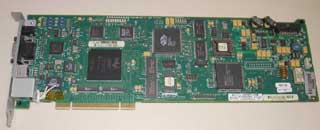
RILOE I board 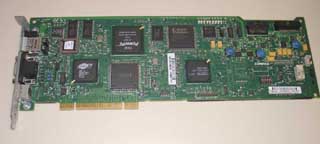
RILOE II board Compaq (and later, HP) produced several incarnations of the Remote Insight Board: 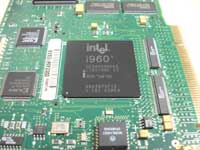
The RILOE I uses an Intel i960 chip 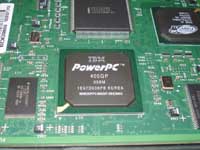
The RILOE II uses a PowerPC chip
- Remote Insight Board
- Full-length PCI card, allows remote text-console access, or graphical OS console through the use of additional software (PC Anywhere).
- Has a bulky rechargeable backup battery pack.
- Options for internal modem, external serial modem and ethernet connectivity.
- Released in 1996, and End-of-Life (EoL).
- Remote Insight Board, Lights-out Edition (RILOE)
- Full-length PCI card, with an embedded web interface
- Fast Ethernet port
- Full graphical keyboard/mouse console access
- Virtual power button, virtual floppy
- External power supply
- ATi Rage IIc PCI graphics chip with 4MB RAM
- Uses an Intel i960 RISC processor at 33 or 66 MHz.
- Released in 1999, EoL.
- Remote Insight Board, Lights-out Edition II (RILOE II)
- Full-length PCI card, with similar functionality as RILOE.
- Added support for virual media (such as CD-ROM via a local drive or CD-image file).
- ATi Rage XL graphics chip
- Uses a PowerPC 405GP processor at 200MHz which gives significantly higher remote console performance.
- Released in 2001. Currently supported by HP (as of 2007)
- Integrated Lights-out (iLO) - an embedded version of the RILOE II on selected HP ProLiant servers. There is an extra network socket on the server labelled 'iLO'. An advanced license needs to be installed to obtain full functionality. Otherwise, remote console, and virtual media functions are not available. Most Generation 3 (and later) servers will have an iLO
I will be mainly discussing RILOE I and RILOE II cards, as these tend to be the most useful and flexible of the 'Lights-out' family.
Compatibility
Surprisingly, HP/Compaq have thoughtfully designed the RILOEs so that they are very standards compliant. When installed in a server, it will appear to the operating system as a memory controller and video display adapter, connected via a PCI-to-PCI bridge. The graphics chip is one based on an older, but popular ATi Rage series. Almost all recent server operating systems will have built-in drivers for the ATi graphics.
They integrate perfectly with most ProLiant servers, and HP provides comprehensive driver support for the device. You can even use the RILOE without installing the additional drivers (which are mainly for management purposes). RILOEs have been successfully used on servers running Linux (or any OS for that matter).
One thing you can do with RILOEs is to use them on other brands of servers, and even non-server hardware. Due to their standard nature, they will work properly more often than not. RILOEs will work on most motherboards conforming to the PCI 2.1 standard. Most motherboards based on an Intel chipset tend to work. The RILOE may fail to work on some motherboards, especially those with older VIA chipsets.
RILOEs have been successfully used to administer white-box computers running windows 2000 and XP. For example, you could set up a dedicated game server at a remote location (such as a datacentre), add a RILOE board, and be able to control it from elsewhere - and only visit the server when you really need to (such as for upgrades and repairs).
Connections and Pinouts
Virtual Power Button (VPB) for RILOE Edition 1 & II
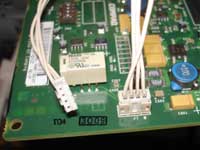
VPB on RILOE II The header for this connection looks identical to the connector used by some soundcards for analogue CD-audio. When connected to a ProLiant system properly, pins 1 and 4 are shorted to let the RILOE know that it has been connected. The relay on the RILOE makes and breaks the connection between pins 2 and 3.
Bridge top and bottom pins (cable detection)
Attach middle pins to ATX [Soft] Power Connector
___
| . | 1 <-+
| . ] 2 <-|--------> ATX Power these two are bridged by the relay
| . | 3 <-|--------> Connector
| . ] 4 <-+
|___|
With this information, you can actually make up (or modify) a cable so that it can be connected to the 'power button' pins on almost any ATX motherboard. The relay provides electrical isolation, so there's no danger of damage from voltage differences or reverse polarity.
There are four actions that can be performed:
| Action | Effect |
| Power on | Power button is pressed for 0.5 seconds |
| Power off (old firmware) | Power button is pressed for 5 seconds |
| Power off (newer firmware) | Power button is pressed for 0.5 seconds to initiate ACPI OS shutdown |
| Power Cycle (Reset) (old firmware) | A system reset is initiated via the PCI bus. Only works on some older ProLiant servers |
| Power Cycle (Reset) (newer firmware) | Power button pressed for 5 seconds, pause 2 seconds, pressed for 0.5 seconds |
External Keyboard and mouse connection
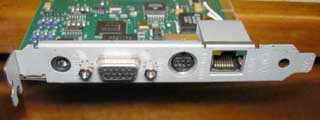
Back connectors on RILOE I 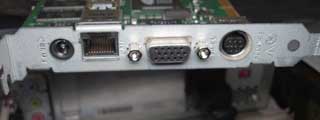
Back connectors on RILOE II Both the RILOE and RILOE II have the same number and type of connections at the rear. As can be seen in the pictures, the positions of the sockets is different for edition 1 and edition II. However, their functions remain the same.
Fortunately, power adapters and Keyboard/Mouse cables are interchangeable between the two models. The power adapter supplies 10v at 1.5A. Voltages as low as 6 or 7 can even be used. However, do not exceed 12 volts or the board will be damaged.
The keyboard/mouse connector uses a 9-pin mini-DIN connection.
Internal 16 and 30 Pin connection
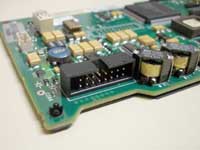
16-pin internal connector on RILOE I 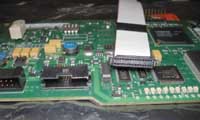
30-pin internal connector on RILOE II At present the exact pin-outs to these connectors are not known - they are proprietary to HP/Compaq. These are designed to be connected to the corresponding connector on the ProLiant server.
The 16-pin connector (on the RILOE I and RILOE II) is known to carry the keyboard and mouse pass-through signals, as well as power for the RILOE (from the standby output of the PSU) when the server is powered off (but still plugged in). If this connector is wired to the system board, the external keyboard/mouse connection on the RILOE should not be used. The keyboard/mouse should be connected to the server normally, and the RILOE and system board will take care of the passthrough automatically.
The 30-pin connector (only available on the RILOE II), being of a much higher density than the 16-pin one, carries additional lines for the virtual media function. This is presumed to be somewhat similar to USB.
Firmware
Firmware - RILOE I
Latest (and last) version: 2.53
Firmware - RILOE II
v1.02 rebrands it from "Compaq" to "HP"
K from FR, Tue, 25 Aug 2009 07:05 am:
smk, Sat, 12 Sep 2009 05:09 pm:
stef, Thu, 08 Oct 2009 05:10 am:
LittleT, Fri, 30 Oct 2009 05:08 am:
mule, Mon, 16 Nov 2009 04:15 pm:
Steve, Fri, 26 Feb 2010 02:54 am:
timfairless, Fri, 12 Nov 2010 03:19 am:
antivirusukffh, Wed, 15 Dec 2010 08:41 am:
Sean, Sat, 15 Jan 2011 09:54 am:
Dan, Tue, 22 Feb 2011 06:47 am:
Slav, Mon, 26 Dec 2011 12:59 am:
Garik, Fri, 01 Jun 2012 06:11 pm:
Dirk, Mon, 16 Jul 2012 01:53 am:
Floyd, Wed, 28 Nov 2012 10:57 am:
Herbert B., Thu, 27 Jun 2013 07:09 pm:
Thomas, Wed, 21 Aug 2013 04:30 am:
Julio, Sun, 08 Sep 2013 10:59 pm:
Marius, Fri, 26 Feb 2016 05:02 pm: